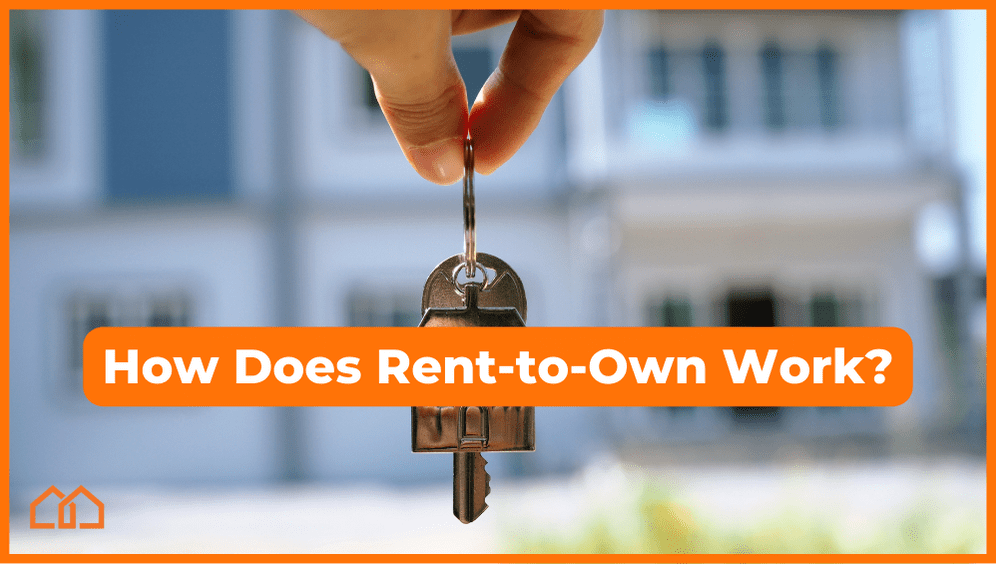How Does Rent-to-Own Work?
What do you do when you want to buy a house, but you need some help gathering a down payment? Or maybe your credit score is less-than-perfect? The great thing about real estate is that there are different ways to become a homeowner. If you can’t go the traditional route, you can still become a homeowner through a rent-to-own agreement.
In this deal, you live in a home as a renter and your rent payments get allocated towards the home’s purchase price. It’s the best of both worlds, enabling people to become homebuyers when they initially don’t have the perfect financial situation to make an offer.
What are rent-to-own homes?
Rent-to-own homes are rentals that the tenants can eventually own after making consistent monthly rent payments for an agreed amount of time. The terms for this type of rental agreement are unique to each property, such as the rental amount and the period of time one must pay rent to obtain ownership of the rental.
Rent-to-own properties are an incredible option for people who are tired of bidding wars, a competitive housing market, and rising home values in a landscape of low housing supply.
What’s different about rent-to-own vs. normal renting?
In a rent-to-own contract, you enter a special agreement where you can become the rental’s owner after the lease term. You may need to pay an upfront “option fee” or “option consideration” that is a nonrefundable fee that you pay to the seller, ranging between 2-7% of the home’s value. If you buy the home, then this money is usually credited toward the purchase price.
Also, you pay a little more rent than the property’s fair market value. The landlord takes this extra money (also called rent credits) and rolls it into your future down payment at the end of the lease. You should enter this agreement with the intention to buy the rental, because if you don’t, then you lose all extra payments and fees at the end of the lease.
In normal renting, you just pay the landlord a monthly rental price to live in the home for the duration of the lease. You do not have the option to buy the home, nor are you obligated to buy the home under the condition of a financial penalty. You also pay a lower monthly rental price since you don’t need to front rental credits toward a future down payment. It’s a more affordable route, but it doesn’t lead to homeownership.
Types of Rent-to-Own Contracts
There are two types of rent-to-own agreements: Lease Option and Lease Purchase. Here are the specifics of each one.
Lease Option Agreement
in a lease option agreement, the renter has the option to buy the home at the end of a lease term. In this contract, the renter pays the landlord an option fee upon signing the rent-to-own agreement. It’s often a rider attached to a normal lease agreement.
During your lease, the rent credits saved go toward your future down payment. In your lease option clause, both parties should agree upon the home’s purchase price, which is backed by an appraisal. If you decide you don’t want to buy the home, then you can let the agreement expire. However, that means you lose your rent credits and option fee.
Towards the end of the lease term, the renter must get approved for a mortgage. Therefore, it’s important to be working with a lender long before your lease term is over to maximize your chances of qualifying.
Lease Purchase Agreement
A lease purchase agreement is similar to a lease option agreement, but with a major difference: you can’t back out of buying the home without a penalty. In this contract, the landlord takes a part of your rent payments and puts them toward a down payment. Both parties agree upon the home’s purchase price at the beginning of the agreement.
Also, the burden on finding a home loan and mortgage lender is on the renter, who should look for a loan while living in the home. At the end of the rent term, the renter should have a loan approved. If the renter doesn’t secure funding by this time, then all the accumulated rent credit is forfeit due to a breach of contract.
How does rent-to-own process work?
Rent to own works by enabling the renter to purchase the home they’re renting at the end of the lease. Though there are different types of rent-to-own agreements, all make it possible for the renter to take over the home as its new owner.
Sometimes, a rent-to-own agreement may involve an agreement that the renter must maintain the property with their own funds, which offsets costs for the landlord and makes it easier to allocate rent credits to the future down payment.
Benefits of Buying a Home Through Rent-to-Own
When you become a homeowner through a rent-to-own agreement, you can essentially “hack” a competitive seller’s market and get a high-quality home without over-offering or losing to another person.
If you’re a first-time buyer with no home equity, this option also gets you on the track to buying a home even when the real estate market is tough. After you pay a one-time upfront fee (for the option contract) and monthly rent credits toward the future sale price of the home, you automate your path toward affording the down payment and closing costs.
Proving you are financially capable of handling these costs will help you as you apply for a mortgage loan to purchase the home at the end of your lease.
The Pros and Cons of Rent-To-Own
Every major life decision comes with a mix of good and bad. Here are the pros and cons of choosing a rent-to-own home.
The Pros of Rent-To-Own
1. You put savings on autopilot.
Being totally honest here, it can be hard to save when you see more money in front of you. Temptations to spend on entertainment and things we may not need are only stronger when saving is an option. But when the money must go directly to your rent credits, you don’t even see it. Instead, it goes toward your future!
2. People with lower credit scores can “hack” the system.
That’s right- you won’t need a pristine financial profile to qualify for rent-to-own. Though you’ll still need to gain your lender and landlord’s confidence, rent-to-own programs aren’t as strict about high credit scores as traditional homebuying programs.
3. You can save on repairs.
Depending on the type of agreement you have, you may be able to split the responsibility for repairs between landlord and tenant. Ask for this provision before signing any agreement if it’s what you need to get through the rental period financially.
4. You can avoid bidding wars.
Bidding wars are still going to be a thing into 2024, unfortunately, but finding a rental home that converts into a sale means you won’t have to worry about competing with others in the open market.
5. You always have a choice.
Regardless of what type of contract you choose, the renter doesn’t have to buy the house. Though there will be a penalty in losing the option fee and/or rent credits, you won’t absolutely have to buy the house if you’re willing to part with the funds you invested.
6. You’ll know exactly what you’re getting into.
Nothing tells you about the condition of a home like living in it. While a home inspection can give you many insights, living in a house tells you so much more. You’ll get to know its quirks, charms, strengths, and weaknesses. By the end of your lease, if the home is good, you’ll have the confidence to proceed with the home buying process.
The Cons of Rent-To-Own
1. You pay higher than market value for your rental home.
Since you will need to pay rent credits toward a future down payment, expect to pay more than your neighbors to rent. This will ultimately be for your benefit, but this extra cost does decrease your margin.
2. You lose money if you back out or don’t secure financing.
Quite possibly the biggest con, losing money when you choose not to buy or can’t secure financing by the end of lease is huge. To avoid forfeiting any money you paid, start talking to a lender ASAP so you can get qualified by the time your lease period is over.
3. Rent credits have a time limit.
For many rental agreements, the lender will only apply the last 12 months of rent credits toward your down payment. If you plan to rent for longer than a year, then you should negotiate a lower purchase price before entering this agreement.
4. Rent credits depend on the appraisal.
If the property’s market rent value comes in higher after signing, then you can’t use your rent credit. To avoid these conundrums, work with a real estate agent to make sure things are being priced correctly.
5. You may be responsible for all repairs.
Though there are agreements where the property owner and tenant go 50/50 on repairs, there is a chance that the owner refuses to be responsible for repairs.
6. You may have to pay property taxes among other fees not attributed to normal renting.
Since you’ll be a future homeowner, lease-to-own contracts often involve cost sharing of some expenses that landlords often handle alone. These include property taxes, homeowners’ insurance premiums, flood insurance premiums, private mortgage insurance, landscaping, repairs, and homeowners’ association fees.
How does the rent to own process work?
If you’re wondering if choosing rent-to-own homes is a good idea, then you’re not alone. It’s an option to buy that people don’t often talk about, but it can offer some substantial benefits to renters who wish to own a home.
If you have any questions about this process, our real estate experts will be glad to answer all your questions! Also, if you’re an investor interested in making some of your homes a rent-to-own property, contact us today.
You May Also Like:
Marketplace Homes Guaranteed Sale Program in Action
At Marketplace Homes, we offer a Guaranteed Sale Program to provide property owners a reliable option to sell their homes quickly and with minimal hassle. Here's a description of how the program works: Initial Assessment: Homeowners interested in the Guaranteed Sale...
5 Little-Known Homebuying Secrets
Hiding in Plain Sight: 5 Secrets That Make Buying a Home More Affordable There are opportunities all over the place to make the path to homeownership easier. Other people are taking advantage of these real estate opportunities, so why not you? Here are 5 secrets that...
Multi-Family Homes Trend in 2024
The Multi-Family Revival How are Americans reacting to still-high interest rates like last year, fierce competition with hopeful renters and single-family homebuyers, and an ongoing affordability crisis? The answer lies in Multifamily Housing. In a challenging housing...
Alicia Persson is a Content Strategist SEO writer at Marketplace Homes, utilizing previous years of experience on real estate teams that specialized in investments and property management. Before she joined Marketplace Homes, she was also a freelance writer for 7 years, leading to a specialization in real estate and home living content for boutique digital marketing agencies. During her writing years, she learned the basics of SEO and gained experience writing for many different clients, making her versatile at creating diverse content.
She is a proud University of Virginia master’s graduate and enjoyed her undergraduate years at the University of Mary Washington. When Alicia is not writing, she plays keytar and sings in a local 90’s rock cover band, or she spends time with her amazing family.





